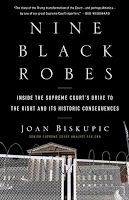With so much in the news recently about ethical behavior of justices and all of the coverage of the one-year anniversary of the Dobbs decision, here are highlights of several newer books about the courts and our judicial system. These three, published in April, May, and June, respectively, focus on the Supreme Court and complement each other – in fact, chapter titles in some correspond to the other book titles.
NINE BLACK ROBES by Joan Biskupic is subtitled “Inside the Supreme Court's Drive to the Right and Its Historic Consequences.” Biskupic, who has written several biographies of Justices and is currently CNN's Senior Supreme Court Analyst, refers to “more than a hundred interviews with people on the court and in its orbit, including a majority of the justices.” She seeks to give an insider perspective, but also is not shy about expressing her own biases. The negotiations described and comments about oral arguments are interesting, but quite detailed. Notes and an index comprise at least twenty-five percent of the text. NINE BLACK ROBES received a starred review from Booklist. (“Devoted Court-watchers will devour this behind-the-scenes exposé.”) although The Wall Street Journal was less flattering in its review (“Unfortunately, Ms. Biskupic too often airs her own dissenting opinions.”).
THE SHADOW DOCKET by Stephen Vladeck has been getting quite a bit of press and was reviewed by Esquire, The New York Times, NPR, and The Wall Street Journal, as well as internationally by The Economist and The Guardian. Here is the featured video from PBS NewsHour:
THE SHADOW DOCKET’s subtitle is “How the Supreme Court Uses Stealth Rulings to Amass Power and Undermine the Republic.” Vladeck, a University of Texas law professor, writes in a very accessible manner as he explains the difference between the “merits docket” – those big cases we are used to studying at school which are resolved in signed, lengthy opinions which may have taken months to craft – and the “shadow docket” which includes more quickly decided cases, often answered with unsigned orders issued quickly and late at night. Vladeck points to numerous examples (on voting rules, redistricting, and even vaccines) of how the court in recent years has used shadow docket rulings to push to the right, including one which refused to block a new Texas law restricting abortions many months before Roe was overturned. Publishers Weekly says, “this insightful and accessible account raises an important alarm.” Have a look.
THE SUPERMAJORITY by Michael Waldman is subtitled “The Year the Supreme Court Divided America.” Yet, Waldman who is president and CEO of the Brennan Center for Justice at NYU School of Law, begins by outlining the court’s history and traces a pattern of overreach and backlash, specifically noting three periods in American history: just prior to the Civil War (1857’s Plessy v. Ferguson as the chief example); early in the twentieth century contributing to reform efforts by Progressives and later vigorous defense of FDR’s New Deal; and the Warren Court (especially 1954’s Brown v Board of Education) and its impact on segregation, civil rights, and voting rights. Reviewing recent events, Waldman also devotes a chapter each to “The Insurrectionists” and the leak of the draft Dobbs decision before ultimately focusing on “Three Days in June,” referring to cases decided last year: Bruen (2nd Amendment rights); Dobbs (reproductive rights); and West Virginia v EPA (climate change). He summarizes, “Dobbs and Bruen were for the Republican Party voters; West Virginia v EPA was for the paying customers. Together these three cases reflected the coalition of religious conservatives, white rural voters, and business interests that have made-up the Republican Party since the 1970s.” His final section looks at future cases dealing with affirmative action, race, and discrimination. He concludes in part by saying, “When norms are broken, reform often follows. The Supreme Court is now ripe for such a response.”
These three texts outline significant concerns about the Court, its members, and public attitudes towards its legitimacy. None are particularly non-partisan, but all seem to speak from sincere concern and deep knowledge of the Court and its traditions. Readers looking for additional perspective could investigate numerous texts, some of which appear in the list of popular Supreme Court books reflecting choices by GoodReads contributors and in the nearly 700 titles related to the Supreme Court for sale at Barnes and Noble.





No comments:
Post a Comment